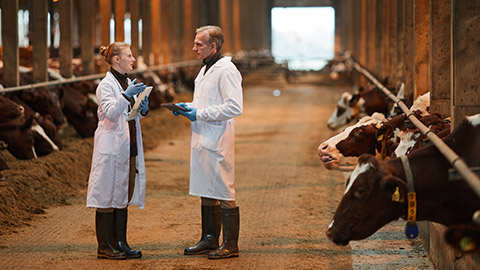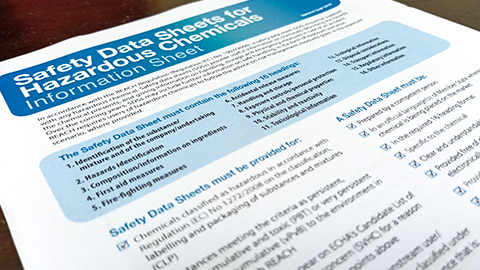When working in an animal care workplace, team members and clients will often ask you for information. Sometimes they will be after pretty basic information with low impact. However, at other times people may require you to provide more in-depth information that has a greater impact on the animal's well-being. It is essential, therefore, that you learn how to provide reputable, current, relevant and accurate information in a timely manner.
In this module, you will learn how to:
- identify animal care information requirements
- source animal care information
- interpret animal care information
- provide information for animal care needs.
In addition, you will learn how to locate, access and identify individual animal records, cross-check this information with relevant care needs, and provide it to team members or clients. Finally, you will learn how to assist with updating animal records as needed.

Interpersonal and communication skills in the workplace
Part of your role in an animal care workplace is to provide information to others. Clients and team members may seek information about:
- a specific animal, its housing, nutritional, health, grooming, enrichment or training requirements
- correct usage, installation, limitations, service or maintenance requirements of animal care equipment
- products or services offered by your workplace.
When someone comes to you for information, your job is to gauge exactly what information they require, how much detail they would like and the time frame in which you must collect it. But how can you achieve this? Thankfully there are specific interpersonal skills you can learn to help you find out what people want to know.
So, what exactly are interpersonal skills?
Strongly associated with emotional intelligence, interpersonal skills refer to how we interact with others.(Dale 2022)
Interpersonal skills include verbal and non-verbal communication, including the management of emotions and attitudes when interacting with people. These skills impact how effectively we get along with and work with others. The following interpersonal skills are particularly important when gathering and confirming the information needs of clients and team members:
- Active listening
- Non-verbal communication
- Questioning techniques.
Active listening
Use active listening to gain information and to confirm that you have understood what you have heard.
Examine and apply the following steps to active listening:
- “Pay Attention: Look at the speaker, be aware of their body language, and ignore distractions.
- Show That You’re Listening: Nod, smile, and say “yes” or “uh-huh” from time to time, to encourage the speaker to continue.
- Provide Feedback: Reflect the speaker’s words back to them and ask questions to check that you understand correctly.
- Defer Judgment: Allow the speaker to finish their point before you offer a counter argument.
- Respond Appropriately: Be open, honest and respectful of the speaker’s opinion – even if you don’t agree with it” (Source: Mind Tools Content Team n.d.).
When speaking with others in the workplace, fully concentrate so that you understand their complete message by using these active listening steps.
Non-verbal communication

Apart from active listening, use non-verbal cues as people are speaking. Fine-tune this ability to add to your interpersonal skills.
A huge part of the way we communicate occurs through non-verbal cues in conversations. This includes your body language, the way you look at others during conversations and the facial expressions you use.(Queensland Government n.d.)
Non-verbal cues include:
- Body language, for example,
- Posture – turn your body to face the other person and lean slightly towards them
- Gestures – smile, nod and use small hand movements
- Eye contact – maintain this to show the other person that you are listening
- Facial expressions – use a natural smile and relax the face (Queensland Government n.d.).
Other points to remember while communicating are to:
- have regard for personal space
- use appropriate vocal tone and body language
- pay attention to what people say and don’t say.
Don’t forget to be aware of the other person’s non-verbal cues as well as your own. Observing and correctly interpreting non-verbal cues will help you determine their information needs as well as the urgency of their request.
Questioning techniques
Add to your interpersonal skills by combining active listening and non-verbal communication with appropriate questioning techniques to fully understand people’s information requests. You will need to ask clients or team members questions to work out what they need to know. There are two main types of questions:
- Open-ended
- Closed-ended.
Both types of questions are useful, particularly when you apply a technique called funnelling, which we will study after examining question types.
Open-ended questions
Open-ended questions require more than just a ‘yes’ or ‘no’ response. Open-ended questions are particularly useful when you need to identify your clients’ or team members’ information needs. They do this by:
- causing a person to think and reflect
- encouraging a person to provide background information and details that would not have been evident otherwise.
Open-ended questions begin with words and phrases such as ‘what’, ‘how,’ ‘why’, ‘describe’, ‘tell me about’ or ‘what do you think about’.
Open-ended questions can be used:
- For gaining information, for example:
- What type of information do you need on this animal care product?
- What concerns do you have?
- What issues has your cat experienced with this type of wormer?
- Seeking advice or assistance, for example:
- What needs updating in this animal record?
- How can I be sure this information is accurate?
- What does this abbreviation mean?
You will notice that the open-ended types of questions are broad, with an aim to gather information without directing the conversation too much. Open-ended questions allow the other person to provide as much detail as they feel is appropriate. There are no right or wrong open-ended questions, but always remember the aim, and shape your questions to address your specific situation to get the information you need (Diaz et al. 2022).
Closed-ended questions
Closed-ended questions are more specific than open-ended questions, requiring ‘yes’ or ‘no’ answers or very specific information. Clear and relevant results can be gained by collecting information with open-ended questions at the start of the conversation. Follow these up with closed-ended questions to clarify and refine that information. (Diaz et al. 2022).
Examples of closed-ended questions include:
- Has your dog been to us before for grooming?
- Is your puppy old enough to go to puppy school?
- How often should I clean my bird’s cage?
If the conversation takes place on the phone, it is more difficult to assess the non-verbal cues. Therefore, use verbal communication techniques, such as questioning and funnelling, discussed next, to help check and confirm that you understand the information needs of the other person.
Funnelling
The funnelling process of refining the information is represented in the following figure.
Funnel your questions by beginning with open-ended questions and finishing up with closed-ended questions. The closed-ended questions will help gain specific details or information that may not have been communicated through open-ended questioning. Therefore, funnel your questions by asking broad, open-ended questions, then finish off with closed, clarifying questions.
Confirm the type of information needed
In the animal care industry, there are three main categories of information that you are likely to be asked about by clients and your team members:
- Animal care products
- Animal care services
- Individual animal information.
Types of animal care products
An animal care product is an item that can be purchased for and used in the care of an animal such as food, a health product or enrichment items. Animal care products include:
| Animal care product category | Description |
|---|---|
| Basic dietary needs | Suitable food that contains essential nutrients, including food items, supplements and treats as well as bowls and feeders |
| Animal housing items | Items used to house animals, such as cages, crates, tanks, carriers, kennels, bedding, etc. |
| Health and hygiene products | Veterinary medications, preventative health products, such as parasite control, and health implements and equipment, such as bandages, thermometers and animal-safe disinfectants |
| Enrichment items | Items that help to improve the quality of life of captive animals, such as toys, specially designed feeders and exercise equipment |
| Grooming products | Items used to care for an animal’s coat, feathers or hair, such as brushes, clippers and shampoos |
| Training products | Items used to assist with the training of an animal, for example, collars, leads and harnesses |
Types of animal care services

An animal care service is work done with or for an animal by someone who is not the owner. Animal care services include:
| Animal Care Service | Examples |
|---|---|
| Boarding and day care facilities |
|
| Grooming services |
For example:
|
| Training services |
For example:
|
| Veterinary and allied health services |
|
| Outsourced services | Outsourced services are contracted from an additional supplier. For example, if a business sells dog doors, it might contract a tradesman (outsourced service) to install those doors. |
Individual animal information

This type of information is specific to the individual animal. Information in this category includes details, such as the individual animal’s:
- name
- basic anatomical features consistent with its species and breed
- life stage
- microchip number
- tags, bands, brands or other visual identifiers
- lineage (records of parents, grandparents and other ancestors)
- health records.
Knowledge check 1
What is reputable information?
When providing information to others you must make sure it is reputable and can therefore be relied upon. Reputable means the information is trustworthy, acceptable and of a good standard (Collins 2022).
It is important to critically evaluate sources because using credible/reliable sources makes you a more informed [worker].(University of Washington Libraries 2022)
Credibility and reliability of information
It is important that you can identify sources of reputable information about animal care products and services, so that you can provide the best quality information to others. Confirm if the information is credible (trustworthy) and reliable (accurate and consistent) before using it.
To test whether the source is credible and reliable, ask yourself the following questions:
- "Accuracy:
- Is the information reliable?
- Is the information error-free?
- Is the information based on proven facts?
- Can the information be verified against other reliable sources?
- Authority:
- Who is the author?
- Does he or she have the qualifications to speak/write on that topic?
- Is the author affiliated with a reputable university or organization in this subject field?
- Objectivity:
- What is the intended purpose of the information?
- Is the information facts or opinions?
- Is the information biased?” (Run Run Shaw Library 2022).
If the source is accurate, authoritative and objective, you can be confident the information is reputable.
The following video (2:56 min) discusses the idea that the credibility of a source is contextual and relies heavily on the specifics of the information you are looking for. While the video discusses sources in terms of formal academic research, the principles of credibility and reliability of sources still apply. However, when providing information about animal care, for the wellbeing of the animal, it is critical that you your source is always reputable and of high credibility and reliability.
Finding reliable information on the internet
The internet is the first place most people will source their information from because it is immediate, convenient and highly accessible. However, the first hit that comes up from an internet search is not necessarily the most reliable. It is important, therefore, to evaluate websites for credibility and reliability.
Anything can be published on the internet without being edited, reviewed or verified. However, hard copy published information and reliable sources of online information tend to use a rigorous process of editing, reviewing and validation for accuracy.
Review the following tips to help you determine if an online source is reputable:
- Scrutinise the domain name
- Determine the source
- Find more information to support your findings (UTEP Connect 2017).
Scrutinise the domain name
Apart from information on the website itself, look for clues in the URL (internet address) as this may indicate where the information has originated:
- .com – a commercial website
- .edu – an educational institution
- .gov – a government department
- .net – a network access provider
- .org – commonly used by non-profit organisations, open-source projects and communities; is an open domain that can be used by anyone (Run Run Shaw Library 2022).
Educational and government sites tend to be the most reputable sources of online information. Commercial and organisational websites tend to be reliable for product and service specifications. However, they may be biased in terms of quality and suitability.
Determine the source
Clues to the reliability of websites include whether important information has been included, such as:
- Is there an author listed, along with credentials?
- Are contact details for the author, such as an email address, available?
- Is there a summary of what the information source is about, for instance, ‘What we do’ or an ‘About’ page for the host of the website?
- Is the information just someone’s own opinions (such as on a blog) – or are they backed up with evidence?
- Is the information up to date? What is the publication date?
Find more information to support your findings
Once you have found online information on the subject you are after, verify its accuracy by checking the information against other reliable sites. If you can validate the information with at least one other reputable website, then you can be confident the information is credible.
If you find contradictory information or you simply can’t find another reliable source with the same information, it is likely that the information is not credible or reliable. In this situation, you may need to restart your research.
Some websites, such as Wikipedia, vary widely in their reliability. Not all the information has been verified and may contain factually incorrect details. Due to this risk, only use such sources to kick-start your research. Do not use it as your main source of information (UTEP Connect 2017).
In summary, evaluate the credibility and reliability of an online source by evaluating the domain name and the author or owner of the information, and try to verify the information with at least one other reliable source before providing the information to others in the workplace.
Validated internet sites
If the internet site is both credible and reliable, it is known as a validated internet site and can be used as a source of reputable information.
Sources of reputable information
When providing information to others, you always want to use the most reputable source you can, to ensure accuracy and reliability of the information. While the internet often seems to be the quickest and easiest place to source information, it can be difficult to validate the sites.
There are several other reputable sources of information that do not require such rigorous validation. The following table summarises the main reputable sources of information regarding animal care products and services, and individual animal information.
| Source of informtion | Description |
|---|---|
| Validated internet sites | The internet contains a wealth of information about animal care products and services. However, only refer to validated sites to ensure the information is accurate. |
| Industry associations |
Industry associations are groups of people with a common goal or interest and who pay to be members. For example, The Pet Industry Association of Australia (PIAA), the Australian Veterinary Association (AVA) and the Australian Animal Protection Society (AAPS). “Association members regularly share information, discuss issues, develop standards and establish rules for best practice within their industry” (ACCC n.d.). |
| Govenment registers |
Federal, state and territory governments keep registers (lists) about certain products manufactured in or imported into Australia and for legislation related to animal welfare and animal care. They also keep registers about animal care industry professionals who require registration, for example, veterinarians. Local councils keep registers on domestic and livestock animals, for example, microchip and owner information for pet cats and dogs. |
| Product brochures and safety data sheets |
Product brochures provide specific information about different products. For example, product ingredients, quantities, measurements and safety precautions. Safety data sheets (SDS) provide information about how to safely handle, use and store specific products. |
| Supervisor and other workplace team members | Your supervisor and other experienced workplace team members may be able to provide specific information or recommendations about products and services. For example, your supervisor may be able to provide a range of options to a client asking for a recommended grooming or boarding facility. |
| Library or workplace resources |
Library and workplace resources include reference books, industry magazines, manufacturers’ instructions and workplace policies and procedures. Individual animal information will likely be stored in databases and information management systems, for example, pedigree databases, and medical and patient histories. |
The type of information you find will depend on the source you use.
Industry associations
Industry associations, such as Animal Care Australia (ACA), Pet Industry Association Australia (PIAA) and Australian Pet Care Association (APCA), provide information about animal care services and products that are relevant to the association.
Most of the information is general in nature unless the association actively endorses a particular brand or service provider. For example, the ‘How to clean a fish tank’ fact sheet by PIAA describes the key steps involved in cleaning a fish tank. While it mentions several products in general, it only specifies one brand.
The AVA article, ‘Baits containing PAPP released for wild dog management’, discusses a new type of bait product that may have adverse effects on domestic pets. While it provides information about the active ingredient of the bait, there is no mention of bait brands.
When providing information about products and services, “associations and their members (regardless of size) must be mindful of their obligations under the Competition and Consumer Act 2010” (ACCC n.d.), which is why associations tend not to endorse specific products or services.
Some industry associations provide information about best practice for various aspects of animal care. They may also report on changes to legislation or guidelines that may affect the animal care industry.
Government registers
Government registers of medications and other products are excellent sources of information regarding changes to regulations of use or product recall announcements, medication or vaccine alerts, or changes to regulations related to products.
“The Australian Pesticides and Veterinary Medicines Authority (APVMA) is the regulator responsible for the recall of agricultural and veterinary (agvet) chemical products that have been supplied to the Australian market” (Australian Pesticides and Veterinary Medicines Authority 2022).
Individual animal registers
Most Australian State and Territory Governments require the registration of animals, by law. Livestock animals are registered on a national level, using the National Livestock Identification System (NLIS), while companion animals are registered in their local councils.
There is a fee to register a companion animal. This fee contributes to the development and maintenance of:
- specific off-lead dog-parks
- dog poo bins
- animal shelters
- pet expos
- free factsheets, information sessions and pet related classes in that council.
Registration fees also pay the wages of staff who:
- collect and return lost animals to their owners
- manage animal shelters
- attend pet behavioural complaints, such as wandering animals, barking or biting incidents
- audit animal care facilities to ensure legal compliance with the Domestic Animals Act 1994 (Agriculture Victoria 2020b).
Microchipping is separate to registration. However, microchip databases are usually linked to the relevant government register and help owners reunite with their animals, should they become lost.
Manufacturer product information
Some animal care product information is typically included on the label or other product packaging. However, full product details can be obtained from the manufacturer, often in the form of a product brochure, fact sheet or webpage. When looking for information about a product online, the manufacturer’s website should be the most reliable source of information.
Safety data sheets

Safety information regarding animal care products is published in the relevant SDS. You should have access to the relevant SDS at your workplace. Check with your supervisor if you are not sure where they are located or how to access them. SDS provide safety-related information about the specific product including:
- The risks associated with ingredients contained in a product, for example, the presence of common allergens
- Information about the suitability of the product, for example, ‘suitable for dogs >25kg’
- Information about how to safely use the product, for example, ‘for external use only’
- Information about how to safely store the product, for example, ‘keep out of reach of children’ or ‘flammable – keep away from fire and heat’
- Information about what to do if risks occur, for example, ‘if ingested, phone the Poisons Information Line on [number]’ or ‘discontinue if skin irritation occurs’
- How to dispose of product containers in a safe and environmentally friendly way, for example, ‘Avoid release to the environment; use destructive techniques for waste and wastewater.’
Make sure the SDS you use is up-to-date and compliant. Review Understanding safety data sheets for hazardous chemicals from Safe Work Australia to help you work out if a SDS complies with WHS regulations and standards.
For some examples of SDS related to animal care, browse the collection from Zoetis, a global company that produces animal medicines, vaccinations and other health products.
Workplace sources
Your workplace will have relevant information on hand in the form of databases and information management systems, and in the existing knowledge of experienced staff.
Supervisor and other team members
If the product in question is an item that your workplace provides or sells, another excellent source of product information will be your supervisor and other more experienced team members who are familiar with the product. If you receive the information in verbal form, make sure to use active listening, questioning and other interpersonal skills to obtain the information needed for the situation.
Workplace databases and information management systems
The product information stored by your workplace will depend on the type of workplace. For example, a pet supply shop will likely store much greater product information than an organisation without a retail component.
If you need to read information, use the previous tips for speedy interpretation of written information.
Scenario: Cat food
A customer at Pets Warehouse asks Sarah what the benefits are of feeding their senior cat with Royal Canin’s Ageing 12+ Jelly compared to a regular adult cat food. Sarah quickly jumped onto the Royal Canin website to see the ingredient list and benefits of the Ageing 12+ Jelly product compared to Instinctive Jelly, an adult wet food of equivalent taste and texture. When comparing the two product ingredient lists, she found the following differences:
| Nutritional information | Ageing 12+ Jelly | Instinctive Jelly |
|---|---|---|
| Vitamin D3 | 350 IU | 100 IU |
| E1 (Iron) | 3 mg | 4 mg |
| E2 (Iodine) | 0.31 mg | 0.3 mg |
| E4 (Copper) | 2.4 mg | 2.5 mg |
| E5 (Manganese) | 1 mg | 1.2 mg |
| E6 (Zinc) | 10 mg | 12 mg |
| Omega-3 fatty acids | High | Unspecified |
Sarah quickly identified that the significant difference was in the vitamin D content. She suggested the 12+ food might be the better option if the cat did not spend much time outside in natural daylight, which would stimulate natural vitamin D production.
Sarah also told the customer that the 12+ food specified the inclusion of omega-3 fatty acids, which help with stiff joints. She also mentioned that the 12+ food is made with small nutritional differences that are specialised to the needs of the targeted age-group, and so really was the better choice for an older cat.
Knowledge check 2
